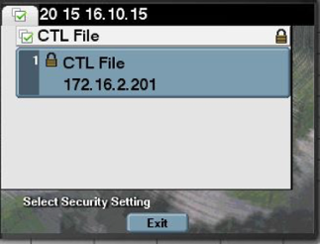In this blog post, we will explore 3 possible troubleshooting solutions in order to identify and resolve the challenges of registering phones to the CUCM.
SOLUTION 1 - Delete Trust Lists
This first solution troubleshoots one of the most common problems when introducing new devices to your Unified Communications environment. Typically, this occurs with pre-used phones who retained the information of the previous CUCM.
Step 1. Unlock the phone and delete the CTL and ITL files.
- Navigate to the security settings on your phone, the location can vary depending on the phone model. Certain models will have a “reset security settings”, others will require you to navigate to the CTL & ITL files manually.
- Use “**#” to unlock your phone and delete the CTL & ITL files.

Step 2. Verify that the phone has registered.
- Once you’ve deleted the security settings, the phone should restart. Verify if it registers.
Want more tips on CUCM please visit us at Stack8
SOLUTION 2 - No Network Connectivity
Step 1. Verification of connectivity via packet capture
- You can take a packet capture by one of two methods, either by using “span PC port” functionality of the phone or by configuring the same functionality on the switch.

Packet Captures can be difficult to read when there is a lot going on, narrow it down the fields as much as possible with the following filters in Wireshark:
- ip.addr eq and ip.addr eq
Step 2. Validate 2-way connectivity
The next thing to do is validate that there is two-way communication between the CUCM and the phone. If there is none, then we can confirm there is no network connectivity.
If there were no network connectivity, you would see traffic originating from your phone’s IP address only, not the CUCM (first column is the originator).
Solution 3 - Validate File Downloadability
Finally, we will want to see is that the phone is able to download its files.
Step 1. Verify that .cnf is being downloaded
.cnf files contain the phone configuration, in the below screen capture we see the GET sent by phone on line 4, we then see the transaction being completed successfully on line 13.

Step 2. Verify that .tlv file is being downloaded
.tlv files contain the security information which allows the phone to trust the CUCM, we see the GET on line 1, and in this case, the CUCM returns “404 Not Found”.

Step 3. Investigate resolution options below
- If you are not able to download any files from CUCM, always ensure that TFTP is permitted on your network, you can also attempt to reboot the TFTP service on CUCM, this will only affect phones which are in the registering process.
- If the phone isn’t finding the .cnf file, it is possible that there is a typo in the device name of the call manager.
- If the phone isn’t finding the .tlv file, it is possible that there is a problem with the TVS service, this service much like the TFTP service will only affect phones which are attempting to register to the call manager. If this is the case, the issue is always widespread and may require the server to be rebooted.
Useful Insights - Phone Traces
Reading traces is an unpopular way of diagnosing problems, however, it can quickly become your go-to technique if you work on it. Don’t ever be afraid to collect logs, whether it be endpoint or server logs, if you have a good idea of what you want to find, you may be able to get it without fully understanding the log file.
The logs we will need for this are the console logs from the phone, we should take the latest one – in this case, I will take /FS/cache/log85.log:

So, once we’re in the log file, if you’re familiar with log files, you can parse through these manually. Alternatively, we can search for keywords which will point us in the right direction. For instance, search for CTL – This will bring you to all of the lines involving certificates.

And in this case, we can see that there is an error – The call manager isn’t in the phone’s trust list. This is why the phone is being rejected from the CUCM.
With the help of these steps, you should be in good shape to diagnose the issue behind why your phone is not registering to your CUCM. Alternatively, you can always reach out and discuss how we can help; The team at Stack8 are experts at troubleshooting Cisco Unified Communications issues for our customers.
